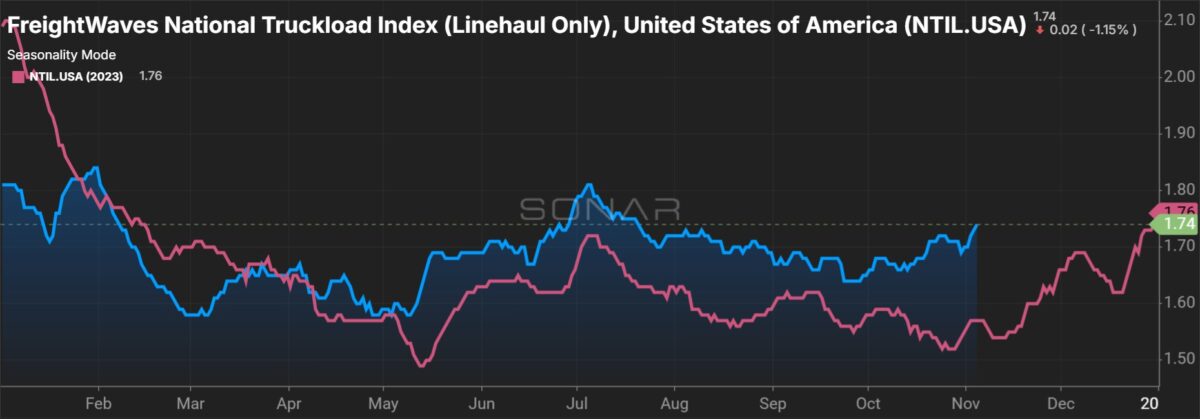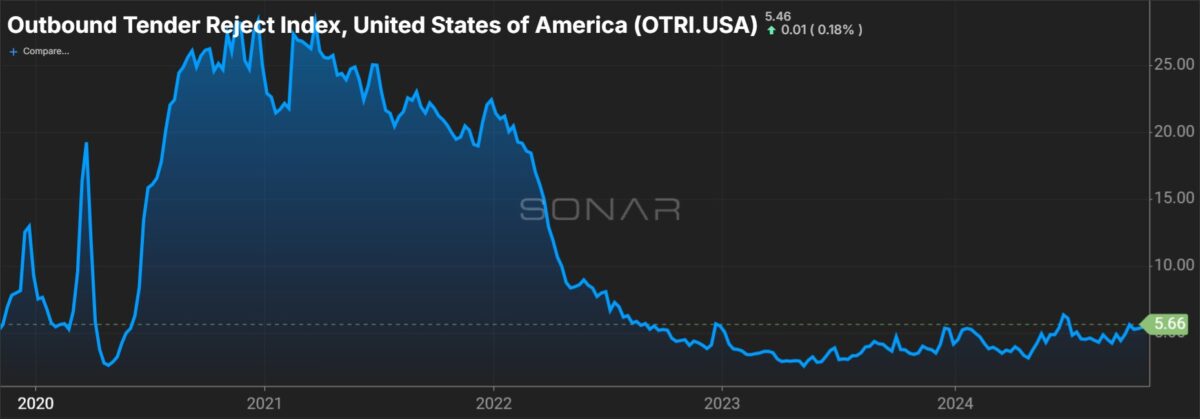A monthly supply chain survey published Tuesday showed a jump in sentiment around transportation pricing. The Logistics Managers’ Index reported a 64.1 reading for transportation prices in October, a 5.7-percentage-point increase from September and the highest reading for the dataset since May 2022.
The LMI is a diffusion index wherein a reading above 50 indicates expansion while one below 50 signals contraction.
The one-year forward expectation for pricing was 81, up 1 point sequentially. If achieved, that would be “a move back to a full-fledged freight boom,” the report said.
Transportation capacity (50.8) moved slightly back into expansion territory, up less than 1 point from September. The trend line for the index has continued to move lower since June of last year.
The capacity index started October in contraction territory (45.8) before flipping to expansion during the last two weeks of the month. Conversely, the prices index registered a 67 reading early in the month, dipping to 61.9 in the second half.
Transportation utilization (59.7) increased 2.1 points sequentially but has remained within a 5-point range the entire year. Utilization was 10 points higher at the wholesale and manufacturing levels of the supply chain than it was at the retail level.
The report noted that as the market tightens capacity could reenter.
“It is possible that as Transportation Prices continue to rise more idle capacity will come off the sidelines to take advantage of the increased opportunity, leading to the somewhat counterintuitive situation that we now find ourselves in where both Transportation Prices and Capacity are increasing.”


The overall index signaled expansion for an 11th straight month, “providing strong evidence that the logistics industry is back on solid footing.” A 58.9 reading in October was the highest since September 2022. However, the 8-year-old index has been below the all-time average of 61.8 for 25 straight months.
“For the last two years, October has been the high-water mark for the overall index as supply chains whirl into motion to push inventory downstream to retailers, and then slow back down as they maintain – rather than build – inventories through the rest of the year.”
Inventory levels (59.4) were down less than half a point but continued to expand in the month. Downstream retailers (65.7) saw significant expansion, “suggesting that retailers are stocked up, and will likely continue to stock up, for the holiday shopping season.”
Total inventory levels were also considerably higher in the first half of the month (66.7) than in the back half (54.1).
The Inventory cost index (65.8) was down 5.5 points with a similar cadence – higher in the first half than in the second.
“When taken together, this suggests that seasonal inventories likely peaked in mid-October and will now come down (while still being continually replenished) due to holiday shopping.”
The warehousing indexes remained in expansion as capacity (55.8) was level with September, utilization (62.9) was up 2 points and the prices subindex (65.8) dipped 1.2 points. However, the report pointed to transportation and warehousing jobs remaining largely unchanged in October as an outlier to normal seasonal patterns ahead of peak season.
The report concluded that the next upswing in the transportation market will likely be more subdued.
“Now that [transportation] prices are increasing, more capacity is being enticed back to the market, making this a softer turnaround than the shock-driven freight booms we saw in 2018 (tax cut) and 2020 (COVID lockdowns). The excess capacity is making the recovery slower than some would prefer. But, as we see from future predictions, its slow and steady nature may make the recovery more sustainable.”
The one-year forward outlook for the overall LMI was 65.7.
The LMI is a collaboration among Arizona State University, Colorado State University, Florida Atlantic University, Rutgers University and the University of Nevada, Reno, conducted in conjunction with the Council of Supply Chain Management Professionals.







